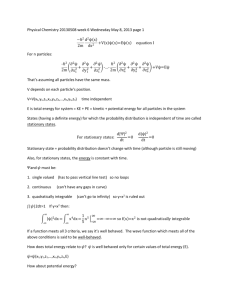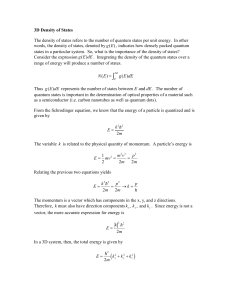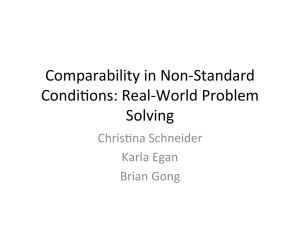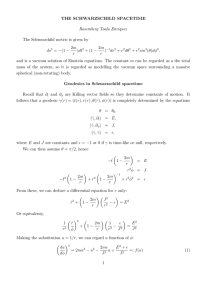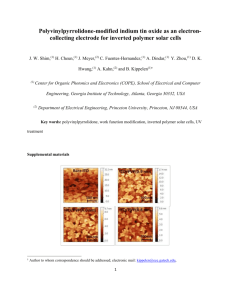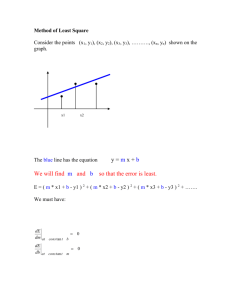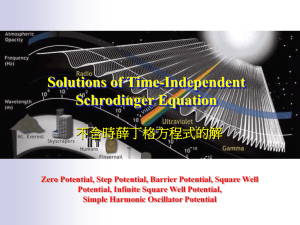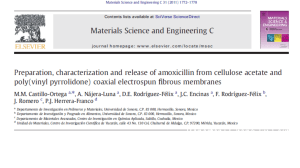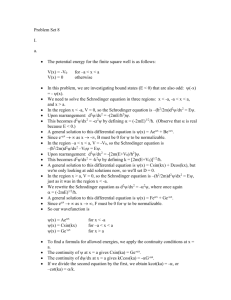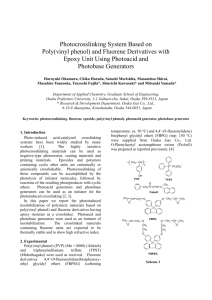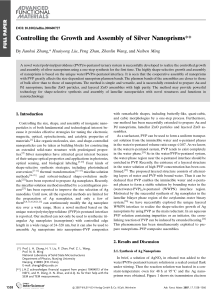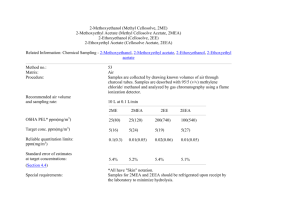Chapter 3 Quantum Mechanics In physics, ei(kr
advertisement
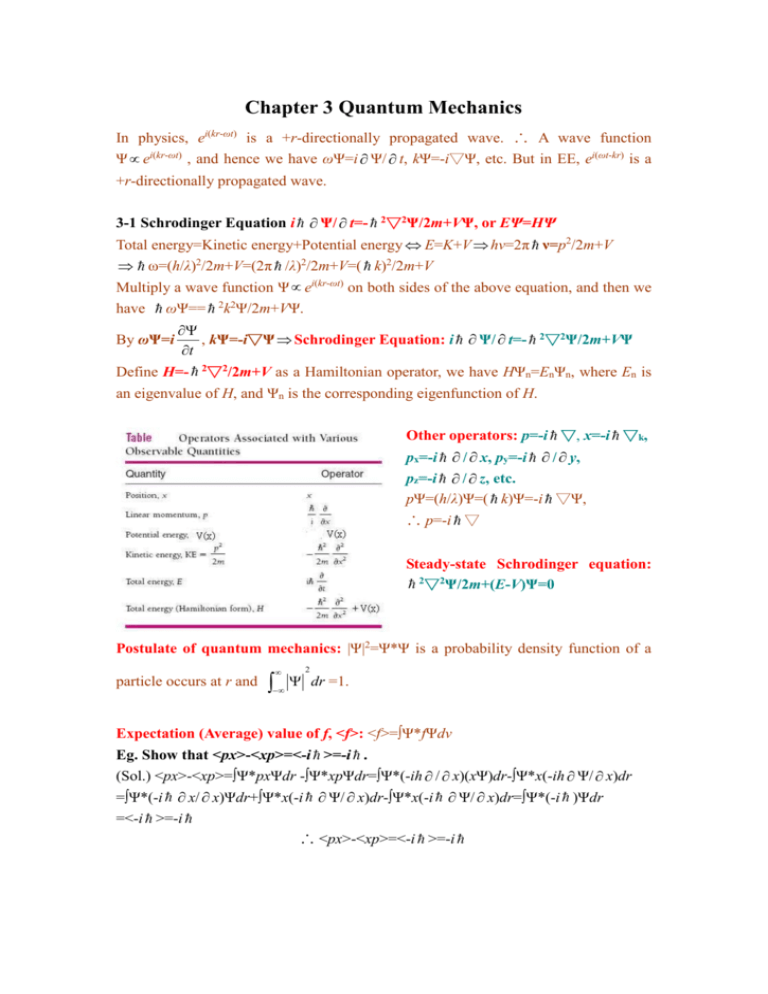
Chapter 3 Quantum Mechanics In physics, ei(kr-ωt) is a +r-directionally propagated wave. ∴ A wave function Ψ ei(kr-ωt) , and hence we have ωΨ=i Ψ/ t, kΨ=-i▽Ψ, etc. But in EE, ei(ωt-kr) is a +r-directionally propagated wave. 3-1 Schrodinger Equation i Ψ/ t=- 2▽2Ψ/2m+VΨ, or EΨ=HΨ Total energy=Kinetic energy+Potential energy E=K+V hν=2π ν=p2/2m+V ω=(h/λ)2/2m+V=(2π /λ)2/2m+V=( k)2/2m+V Multiply a wave function Ψ ei(kr-ωt) on both sides of the above equation, and then we have ωΨ== 2k2Ψ/2m+VΨ. By ωΨ=i , kΨ=-i▽Ψ Schrodinger Equation: i Ψ/ t=- 2▽2Ψ/2m+VΨ t Define H=- 2▽2/2m+V as a Hamiltonian operator, we have HΨn=EnΨn, where En is an eigenvalue of H, and Ψn is the corresponding eigenfunction of H. Other operators: p=-i ▽, x=-i ▽k, px=-i / x, py=-i / y, pz=-i / z, etc. pΨ=(h/λ)Ψ=( k)Ψ=-i ▽Ψ, ∴ p=-i ▽ Steady-state Schrodinger equation: 2▽2Ψ/2m+(E-V)Ψ=0 Postulate of quantum mechanics: |Ψ|2=Ψ*Ψ is a probability density function of a particle occurs at r and 2 dr =1. Expectation (Average) value of f, <f>: <f>=∫Ψ*fΨdv Eg. Show that <px>-<xp>=<-i >=-i . (Sol.) <px>-<xp>=∫Ψ*pxΨdr -∫Ψ*xpΨdr=∫Ψ*(-ih / x)(xΨ)dr-∫Ψ*x(-ih Ψ/ x)dr =∫Ψ*(-i x/ x)Ψdr+∫Ψ*x(-i Ψ/ x)dr-∫Ψ*x(-i Ψ/ x)dr=∫Ψ*(-i )Ψdr =<-i >=-i ∴ <px>-<xp>=<-i >=-i Case 1 Quantum well with infinitely hard walls: 0, 0 x L V= , elsewhere d2Ψ/dx2+2mEΨ/ 2=0 in 0≦x≦L Ψ(x)=Asin( Boundary conditions: Ψ(0)=Ψ(L)=0 B=0, En= 2mE 2mE x)+Bcos( x) n 2 2 2 , and Ψn(x)=Asin(nπx/L) 2mL2 2 n dv =1 A= 2 / L , ∴Ψn(x)= 2 / L sin(nπx/L) Case 2 Quantum well with finite potential walls V: 0, 0 x L V= V , elsewhere d 2 I 2 m 2 ( E V ) I 0 2 dx d 2 II 2m 2 II 0 2 2 dx d 2 m III 2 ( E V )III 0 dx 2 with boundary ΨII(L)=ΨIII(L), ΨI’(0)=ΨII’(0), ΨII’(L)=ΨIII’(L) I ( x) Cex 2mE x 2mE x ) B cos( ) II ( x) A sin( III ( x) De x conditions: ΨI(0)=ΨII(0), Case 3 Tunnel effect: A barrier of V>E, V ( E ), 0 x L V= elsewhere 0, d 2 I 2 m 2 EI 0 2 dx 2 d II 2m 2 ( E V )II 0 2 dx 2 d 2m III 2 EIII 0 2 dx with boundary conditions: ΨI(0)=ΨII(0), ΨII(L)=ΨIII(L), ΨI’(0)=ΨII’(0), ΨII’(L)=ΨIII’(L) I ( x) Ae ik1x Be ik1x 2mE , II ( x) Ce ik2 x De ik2 x , where k1= ik3 x III ( x) Fe 2m(V E ) 2mE , k3= =k1 16 2 k2 L e 2 k 2 L Transmission probability: T=|ΨIII+|2/|ΨI+|2=|F|2/|A|2 [ 4 ( K / K ) 2 ] e 2 1 k2= Eg. A beam of electrons is incident on a barrier of 5eV high and 0.2nm wide. What energy should they have if 50% of them are to get through the barrier? 16 2 k2 L e 2 k 2 L =0.5 (Sol.) T= [ 4 ( K / K ) 2 ] e 2 1 k2=1.7×109= 2m(V E ) , V=5 E=4.89eV Case 4 Harmonic oscillator with frequency ν= dΨ2/dx2+2m(E-kx2/2)Ψ/ 2=0. Define y= k m 2 : V=kx2/2 km 2mv 2E x= x and α= m 2E = k h dΨ2/dy2+(α-y2)Ψ=0. Define Ψ=f(y)exp(-y2/2) df2/dy2-2ydf/dy +(α-1)f=0 Let f(y)= An y n An 2 n 0 2n 1 An . If α=2n+1 An+2=An+4=An+6=…=0 (n 2)( n 1) Ψ=f(y)exp(-y2/2)→0 as y→±∞. ∴ Choose α=2n+1. ∵ α= 2E =2n+1, ∴ En=αhν/2=(n+1/2)hν h 2 n dv =1 Ψn= ( 2 m 1 / 4 n ) (2 n!)1 / 2 Hn(y)exp(-y2/2), where Hn(y) is a Hermite polynomial of order n. 3-2 Uncertainty Principle △p.△x≧ /2, △E.△t≧ /2 Consider 1-D case. Define <△x2>=∫Ψ*(x-<x>)2Ψdx, <△px2>=∫Ψ*(px -<px>)2Ψdx, and take <x>=<px>=0 without any loss of generality. px= -i / x <△px2><△x2>= 2 - ∫Ψ* 2 dx.∫Ψ*x2Ψdx x 2 * * 2 ∵ ∫Ψ* 2 dx=-∫Ψ* i (i )dx=-Ψ* i (i )dx=-∫ ( )dx +∫ i x x x x x x x x * ∴ <△px2><△x2>= 2∫ ( )dx.∫Ψ*x2Ψdx x x By Schwarz inequality, ∫ff*dx.∫gg*dx≧[(∫fg*dx+∫gf*dx)/2] 2 <△px2><△x2>≧ * * 2 2 [∫ xΨ*dx+∫xΨ dx] 2= [∫x dx] 2 x x x 4 4 x 2 2 [ΨΨ*x -∫ΨΨ* dx] 2= . Define <△x>=<△x2>1/2, <△px>=<△px2>1/2 x 4 4 △p.△x≧ /2 = Eg. A typical atomic nucleus is about 5×10-15m in radius. What is the lower limit on the momentum an electron must have if it is to be part of a nucleus? (Sol.) △x=5×10-15m, △p.△x≧ /2 △p≧1.1×10-20Kg.m/sec
